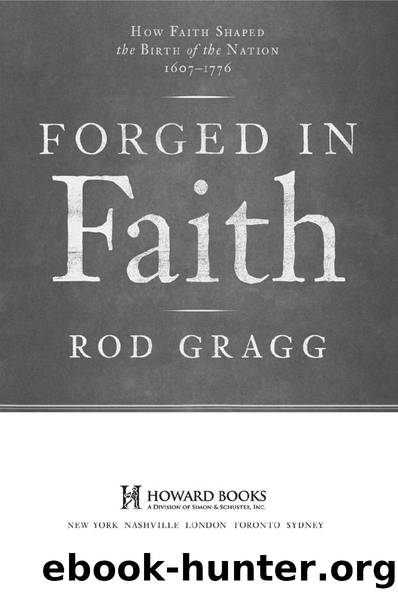Forged In Faith by Rod Gragg

Author:Rod Gragg
Language: eng
Format: epub
Publisher: Howard Books
Published: 2010-07-15T00:00:00+00:00
In Virginia, the news from Boston arrived as the colony’s House of Burgesses was convening. Patriot leader Richard Henry Lee hastily assembled an impromptu caucus of like-minded legislators that included Patrick Henry and a young lawyer named Thomas Jefferson. Huddled in the capitol’s empty legislative chamber, the determined band plotted a strategy to assist Massachusetts and defend American liberty. Their solution: a day of “Fasting, Humiliation and Prayer” in Virginia on June 1, the day Boston’s port would be closed. Henry and Jefferson researched Puritan fast day proclamations from a century earlier and used them as a model for the resolution. 26
“We were under conviction of the necessity of arousing our people from the lethargy into which they had fallen,” Jefferson would later recall. Given the devotion of the day, a call for prayer was much more likely to pass the legislature than a political proclamation. It would unite Virginians in an act of faith, while protesting the government’s punishment of Massachusetts. As he helped draft the prayer resolution, did Patrick Henry think about the lessons he had learned from his old mentor, Samuel Davies? “The rising generation did not remember, as Henry did, how Samuel Davies had raised patriotic fervor,” historian Henry Mayer would note. In its final, Puritan-inspired language, the resolution called on Virginians everywhere “devoutly to implore the Divine Interposition for averting the heavy Calamity, which threatens Destruction to our civil Rights, and…to give us one Heart and one Mind firmly to oppose, by all just and proper Means, every Injury to American Rights.” 27
On May 24, 1774, the House of Burgesses passed the fast day resolution without changing a word and with no dissenting votes. The legislators would officially observe the day, it was agreed, by marching together to the local Anglican church for prayer. The resolution was quickly printed as a flyer—a “broadside” in the vernacular of the day—distributed on the streets of Williamsburg, and carried by dispatch riders to villages and towns throughout Virginia. It energized Patriot support in Virginia like a “shock of electricity,” according to Thomas Jefferson. It also shocked Virginia’s royal governor, the Earl of Dunmore, who showed up in the legislative council chambers with the broadside in hand. The proposed day of prayer and fasting was an insult to the king and Parliament, he pronounced. As punishment, he ordered the House of Burgesses dissolved. 28
Undeterred, the Virginia legislators trudged over to the nearby Raleigh Tavern, where they reassembled in the Apollo Ballroom. There, eighty-nine censured Virginia lawmakers—Patrick Henry, George Washington, Peyton Randolph, Richard Henry Lee, and Thomas Jefferson among them—drafted a new resolution. In it, they declared that “an attack, made on one of our sister colonies…is an attack made on all” and politely criticized London for “the unconstitutional principle of taxing the colonies without their consent.” Patrick Henry fretted that the response was “much too feeble,” but it concluded with an understated but epic recommendation for “deputies from the several colonies of British America, to meet in general congress.” The document’s polite language belied its importance.
Download
This site does not store any files on its server. We only index and link to content provided by other sites. Please contact the content providers to delete copyright contents if any and email us, we'll remove relevant links or contents immediately.
The Gnostic Gospels by Pagels Elaine(2495)
Jesus by Paul Johnson(2330)
Devil, The by Almond Philip C(2303)
The Nativity by Geza Vermes(2202)
The Psychedelic Gospels: The Secret History of Hallucinogens in Christianity by Jerry B. Brown(2137)
Forensics by Val McDermid(2071)
Going Clear: Scientology, Hollywood, and the Prison of Belief by Lawrence Wright(1959)
Going Clear by Lawrence Wright(1936)
Barking to the Choir by Gregory Boyle(1806)
Old Testament History by John H. Sailhamer(1787)
Augustine: Conversions to Confessions by Robin Lane Fox(1752)
The Early Centuries - Byzantium 01 by John Julius Norwich(1713)
A History of the Franks by Gregory of Tours(1701)
A Prophet with Honor by William C. Martin(1701)
Dark Mysteries of the Vatican by H. Paul Jeffers(1694)
The Bible Doesn't Say That by Dr. Joel M. Hoffman(1666)
by Christianity & Islam(1606)
The First Crusade by Thomas Asbridge(1584)
The Amish by Steven M. Nolt(1546)
